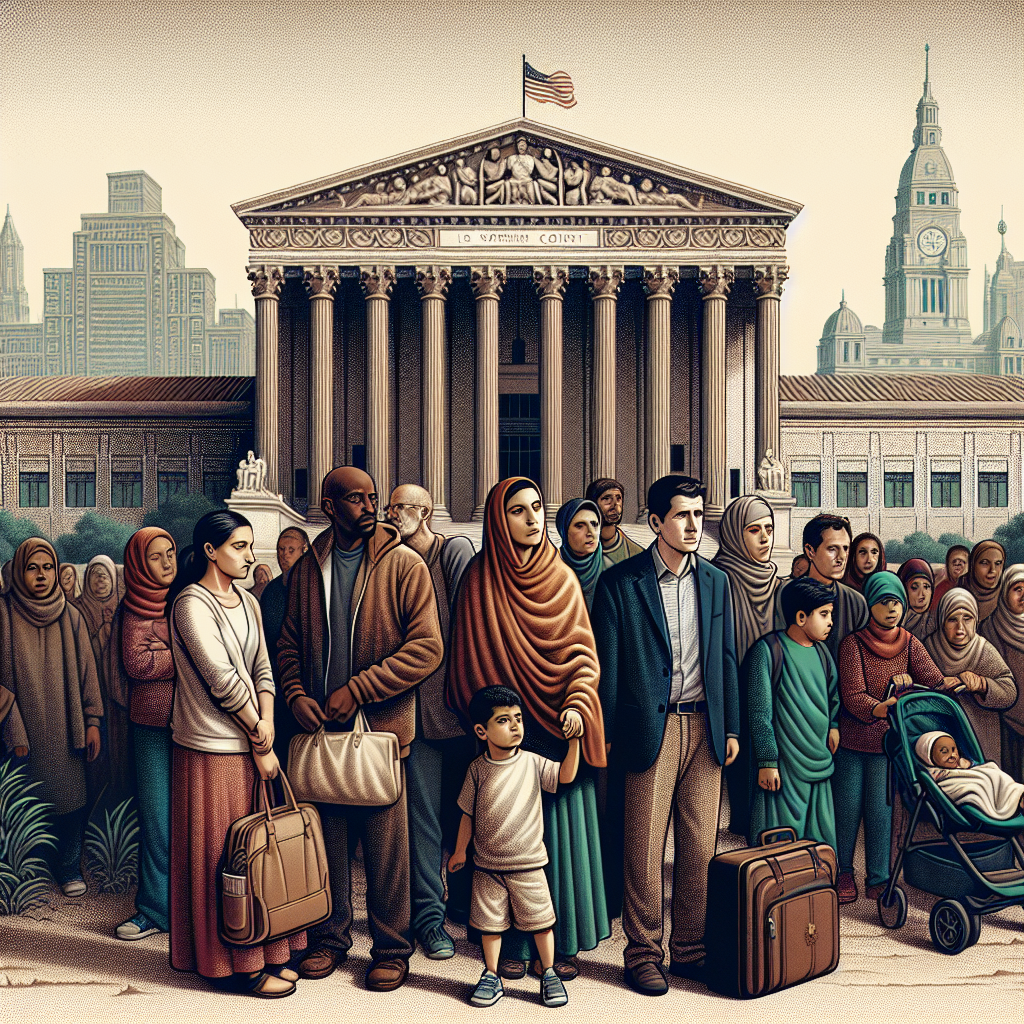On December 1, the Supreme Court will deliberate on the case of Urias-Orellana v. Bondi, focusing on the critical role of federal courts in asylum proceedings. This case raises significant questions about whether federal appellate courts should defer to the Board of Immigration Appeals (BIA) when evaluating claims made by asylum seekers. The decision could have far-reaching implications for countless individuals seeking refuge from persecution.
Background of the Case
The legal challenge originates from the asylum application of Douglas Humberto Urias-Orellana, Sayra Iliana Gamez-Mejia, and their minor child, who fled El Salvador in 2021. They escaped a dire situation involving threats of violence from a hitman associated with a local drug lord. The family contends that their lives were in jeopardy due to their association with Urias-Orellana’s half-brother, who had previously been targeted by the hitman. This context sets the stage for their claim under the Immigration and Nationality Act (INA), which offers protections to those who face persecution.
Upon applying for asylum, the family appeared before an immigration judge, who ultimately denied their request. The judge ruled that the threats they experienced did not meet the legal definition of persecution as outlined in the INA. Specifically, the judge noted that the family’s experience failed to demonstrate a well-founded fear of persecution based on the criteria established by immigration law. This decision has now prompted an appeal that is being reviewed by the highest court in the land.
Legal Implications of the Supreme Court’s Decision
The Supreme Court’s forthcoming ruling will likely clarify the extent to which federal courts can intervene in asylum cases. In previous cases, the role of federal courts has been contentious, particularly regarding the deference owed to the BIA. A decision favoring greater judicial oversight could empower courts to take a more active role in assessing the credibility of asylum claims, potentially reshaping the landscape of immigration law.
Moreover, the case underscores the broader implications for asylum seekers facing similar predicaments. If the Court decides that federal appellate courts should not defer to the BIA, it could pave the way for more asylum claims to be heard on their merits. This could significantly alter the dynamics of the immigration system, especially for families fleeing violence and persecution.
Case Specifics and Broader Context
The Urias-Orellana family’s situation reflects a growing concern over the treatment of asylum seekers in the United States. As they navigated the immigration process, they faced not only the challenges of legal representation but also the emotional toll of their circumstances. The case highlights the necessity for a fair and just immigration system that recognizes the complexities of individual situations.
As the Supreme Court prepares to hear arguments, the legal community is closely monitoring the implications of their decision. The outcome may influence future cases involving asylum seekers and set a precedent for how federal courts interact with administrative agencies. As such, the case is pivotal not only for the Urias-Orellana family but also for countless others who seek asylum in the United States.

| Key Terms | Definitions |
|---|---|
| Asylum | Protection granted to individuals in the U.S. who have fled persecution. |
| Refugee | A person forced to flee their country due to persecution. |
| Board of Immigration Appeals | The highest administrative body for interpreting immigration laws. |
| Immigration and Nationality Act | The primary body of law governing immigration in the U.S. |
As the Court weighs its options, the outcome will undoubtedly resonate beyond the immediate case, impacting the broader framework of immigration policy. The ramifications of their decision could redefine how asylum cases are processed in the future, highlighting the critical balance between judicial oversight and administrative authority. This balance is essential for ensuring that individuals fleeing violence and persecution receive the protection they deserve, as emphasized in the ongoing conversations about immigration reform.
In a related context, the Court’s attention to immigration issues is not new. Previous cases, such as those involving the compassionate-release statute, have showcased the judiciary’s role in addressing complex legal questions surrounding immigration and asylum. As these discussions evolve, the implications for those seeking safety in the U.S. remain a priority for advocates and policymakers alike.
The upcoming Supreme Court case, Urias-Orellana v. Bondi, is poised to address critical issues surrounding the federal judiciary’s involvement in asylum claims. This case specifically questions whether federal courts should defer to the Board of Immigration Appeals (BIA) when reviewing asylum seekers’ claims of persecution. The implications of this decision could significantly affect the standard of judicial review applied in asylum cases, ultimately influencing the outcomes for many individuals seeking refuge in the United States.
Background of the Case
The case centers on Douglas Humberto Urias-Orellana, Sayra Iliana Gamez-Mejia, and their minor child, who fled El Salvador in 2021 due to severe threats from a hitman associated with a drug lord. This family contends that they are victims of persecution, as defined under the Immigration and Nationality Act (INA). The family’s ordeal began when they were targeted due to their connection to Urias-Orellana’s half-brother, who had previously clashed with the sicario over a personal dispute. This history of violence, including the tragic murders of Urias-Orellana’s half-brothers, prompted the family to seek asylum in the United States.
Upon applying for asylum, the family presented their case before an immigration judge. The judge, however, ruled against their request, concluding that their experiences did not meet the legal criteria for persecution as outlined in the INA. The judge’s decision raised various concerns, including whether the threats faced by the family constituted a well-founded fear of persecution. This ruling has now been challenged, bringing the case before the Supreme Court.
Legal Implications of the Supreme Court’s Decision
The Supreme Court’s consideration of Urias-Orellana v. Bondi could redefine the balance of power between federal courts and immigration authorities. If the Court decides that federal courts must defer to the BIA’s judgment, this could lead to a more restrictive interpretation of asylum eligibility. Such a ruling might reinforce the existing burdens of proof that asylum seekers must meet, which are already seen as quite stringent. For a deeper understanding of these immigration burdens of proof, one can explore available resources that detail the challenges faced by asylum seekers.

Conversely, if the Court rules in favor of the asylum seekers, it could pave the way for a more favorable judicial review process for future cases. This would empower federal courts to take a more active role in evaluating asylum claims, potentially leading to more favorable outcomes for individuals fleeing persecution. The stakes are high, not just for the families involved in this case, but for countless others who may find themselves in similar situations.
As the Supreme Court prepares to hear this pivotal case, the legal community and advocates for immigrants are closely monitoring the proceedings. The outcome could set a precedent impacting how asylum cases are adjudicated across the nation. Understanding the key issues at play is crucial, especially as the Court has agreed to address other significant matters, including a major election law case that could also influence the political landscape.
The Supreme Court’s impending decision in the case of Urias-Orellana v. Bondi marks a significant moment in the ongoing discourse surrounding the federal judiciary’s role in asylum proceedings. As the justices grapple with the question of whether appellate courts should defer to the Board of Immigration Appeals (BIA) when evaluating asylum claims, the ramifications of their ruling could reshape the landscape of immigration law in the United States. This case not only highlights the complexities involved in asylum adjudications but also underscores the precarious situation faced by many asylum seekers fleeing violence and persecution in their home countries.
Legal Context of Asylum Claims
The Immigration and Nationality Act (INA) serves as the foundation for asylum claims in the U.S., providing a legal framework for individuals seeking refuge from persecution. Under this law, a refugee is defined as someone who has fled their country due to a well-founded fear of persecution based on specific grounds such as race, religion, nationality, membership in a particular social group, or political opinion. In the Urias-Orellana case, the family asserted that their fear stemmed from threats related to their association with a family member, which they argued should qualify them for asylum under the INA. However, the immigration judge ruled against their claim, stating that the threats they encountered did not meet the legal threshold of persecution.
As the Supreme Court considers this case, the justices will have to determine the extent to which federal courts should respect the BIA’s interpretations of asylum claims. This question is particularly pressing given the increasing number of asylum seekers arriving at U.S. borders, many of whom are escaping dire situations similar to that of Urias-Orellana and his family. The outcome of this case could set a precedent that influences how lower courts handle future asylum claims, potentially leading to more stringent requirements for proving eligibility.
The Implications of Judicial Deference
If the Supreme Court rules that federal appellate courts must defer to the BIA’s judgment, it could significantly limit the ability of asylum seekers to challenge unfavorable decisions. Such a ruling might lead to a scenario where the BIA’s determinations are treated as nearly absolute, reducing the judicial oversight that has historically allowed courts to intervene in cases where asylum seekers have been wronged. Advocates for asylum seekers argue that this could undermine the rights of individuals fleeing life-threatening situations, as it may encourage a more rigid interpretation of what constitutes persecution.

Conversely, a decision that empowers federal courts to independently evaluate asylum claims could enhance protections for those in need of refuge. It could foster a more nuanced understanding of the varying contexts in which persecution occurs, acknowledging that threats can arise from a multitude of social dynamics. This would align with the intent of the INA to protect individuals who face genuine risks in their home countries, thus reinforcing the U.S. commitment to human rights and international obligations.
Broader Consequences for Immigration Law
The implications of the Supreme Court’s ruling in Urias-Orellana v. Bondi extend beyond the immediate case, potentially influencing broader immigration policies and practices. As the legal landscape evolves, the treatment of asylum claims will likely be scrutinized more closely, affecting how courts interpret the INA and the rights of asylum seekers. Legal scholars and practitioners will be watching closely to understand how this decision may alter the balance between judicial oversight and administrative discretion in immigration matters.
Moreover, the case highlights the ongoing challenges faced by immigrants in navigating a complex legal system. Asylum seekers often lack the resources necessary to mount a robust legal defense, which can result in significant disparities in outcomes based on the interpretation of laws by judges. The Supreme Court’s decision could either alleviate or exacerbate these disparities, depending on the direction taken.
Ultimately, the Supreme Court’s ruling will reverberate through the immigration system, impacting not only the individual cases but also shaping public perception and policy regarding asylum seekers. As this pivotal moment approaches, the legal community and advocates for immigrant rights remain hopeful for a decision that upholds the principles of justice and fairness.
In the context of immigration law, the ice contractor appeal case also illustrates the complex interplay between different legal standards and the judiciary’s role in ensuring equitable treatment for all individuals seeking refuge.